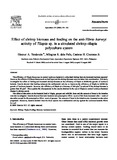Assessment of tilapia-freshwater prawn co-culture schemes in tanks and lake-based cages for increased farm production

Associated URL
www.mdpi.comDate
2021-12-08Page views
565Metadata
Show full item recordCited times in Scopus
Share
Abstract
The technical viability of tilapia (I-ExCEL strain Nile or red) and giant freshwater prawn (GFP) co-culture in cages-within-tanks was evaluated while appropriate feeding protocols for tilapia-GFP co-culture in cages in a eutrophic lake were determined. Specifically, production parameters in all test species grown for five months in tank co-culture (where only tilapias were fed) were compared, while the best feeding protocol from among the following treatments: (a) Tfed—fed tilapias; (b) GFPfed—fed prawns and (c) T-GFPfed—both species fed, were defined. I-ExCEL Nile tilapias grew faster in tank co-culture whether reared singly or otherwise. However, red tilapia-GFP tank co-culture gave the best results considering key production traits in all test species (red tilapia —2.52%/day specific growth rate or SGR, 83.3% survival; GFP—1.17%/day SGR, 72.85% survival). Lake-based co-culture was technically feasible at stocking densities of 12.5/m2 for tilapia and 2.4 to 4/m2 for prawns even when only tilapias were fed; prawns grew to desired marketable sizes by thriving mainly on detritus and natural food organisms in the lake. However, further refinements can still be made to optimise the co-culture schemes to make them more sustainable and provide artisanal fish farmers options in increasing farm yields through multi-species aquaculture.
Description
Supplementary Materials
The following are available online at https://www.mdpi.com/article/10.3390/su132413574/s1, Figure S1: Growth (SGR) of the different freshwater aquatic species (Nile tilapia, red tilapias, prawns) reared for five months using the cage-in-tank monoculture and/or co-culture schemes, Figure S2: Survival of all the freshwater aquatic species reared in the cage-in-tank monoculture and/or co-culture systems, Figure S3: Specific growth rates of the tilapias and prawns reared in lake-based co-culture systems using different feeding schemes, Figure S4: Survival of the co-cultured tilapias and prawns in the lake-based cages using different feeding protocols, Figure S5: Results of plankton monitoring in the lake facility, wet season run, Figure S6: Results of plankton monitoring in the lake facility, dry season runSuggested Citation
Romana-Eguia, M. R. R., Rutaquio, M. P., Gutierrez, R. C., & Salayo, N. D. (2021). Assessment of tilapia-freshwater prawn co-culture schemes in tanks and lake-based cages for increased farm production. Sustainability , 13(24), 13574. https://doi.org/10.3390/su132413574
Subject
Collections
- AQD Journal Articles [1249]
Related items
Showing items related by title, author, creator and subject.
-
Small-scale freshwater aquaculture development: Experiences from the Philippines on giant freshwater prawn, milkfish and tilapia
Aya, Frolan (Japan International Cooperation Agency, 2013-12)The Aquaculture Department of the Southeast Asian Fisheries Development Center (SEAFDEC/AQD) has been promoting a number of programs towards effective dissemination and adoption of science-based aquaculture technologies ... -
Effect of shrimp biomass and feeding on the anti-Vibrio harveyi activity of Tilapia sp. in a simulated shrimp–tilapia polyculture system
Tendencia, Eleonor; dela Peña, Milagros R.; Choresca, Casiano H., Jr. (Elsevier, 2006)The efficiency of Tilapia hornorum to control luminous bacteria in a simulated shrimp farm environment has been reported. However, the effects of different factors such as feed input and the shrimp biomass were not taken ... -
Tilapia farms in Luzon, Visayas, and Mindanao
Aldon, Eva T. (Aquaculture Department, Southeast Asian Fisheries Development Center, 1998)




